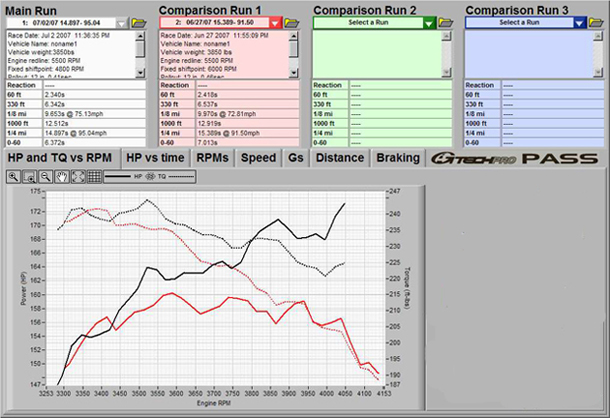FI Air Gap Intake Update
7-18-07
These manifolds are going to be a problem. Our local test vehicles owner, with a 2003 Dakota R/T, cant keep his foot out of it. I have to admit, it has changed the character of the truck (Wow!).
Test vehicle: We are using this close-to-stock 2003 Dakota R/T because we wanted to see what our manifold would do to help the mildest application we could find. This truck has a stock engine with a modified, stock throttle body. However, we used the same throttle body with both tests. The exhaust is stock with a flowmaster muffler, a stock ECU, 180 thermostat and a small round carburetor-type air cleaner that I am sure is costing him some power.
Testing: We have decided against actual dragstrip testing for several reasons. The nearest track is 125 miles away, only open on Saturday nights and setting up slicks and wheels for a day at the track is not cost effective. Without traction bars and proper shocks, we are not getting true results, and most of our customers vehicles will never see the strip. We wanted to get some more real-life, street, before-and-after testing times. We are using a G-tech Pro accelerometer. This device is well respected in the industry and we are able to download results and tests any time that we need to.
A new part like the FI Air Gap brings into focus other shortcomings. For example, this truck automatically up-shifts at about 5000 RPM. At 5000 RPM the engine is still pulling very hard and you are not near the new HP peak, so it does not allow the manifold to show what it really can do.
We could accelerate faster, showing more HP and torque if the engine could wind higher or if the spark advance and fuel curve were changed. But, as I stated before, we wanted a mild stock test vehicle (which we have). This is the racer in us, we always want more and this manifold is a very key component in that quest.
Having said all of that, you probably think the test is going to be a letdown. Not so, reversion breath!
OEM FI Air Gap Improvement
60ft 2.418 sec 2.340 sec .078 sec
330ft 6.537 sec 6.342 sec .195 sec
1/8 m 9.97@72.81 MPH 9.653@75.13 MPH .317 sec (+2.32mph)
1/4 m 15.389@91.50 MPH 14.897@95.04 MPH .492 sec (+3.54mph)
0-60 7.013sec 6.372sec .641 sec Faster
It picked up nearly .50 ET in the quarter mile and over 3.5 MPH. Notice that the quarter mile ET percentage difference is considerably more than the 60ft or 330ft percentage times. This is because of the engine pulling so much harder from 3500 RPM. We were hoping for a .3 improvement in the quarter mile, so to say that we are excited about nearly .5 with this intake is an understatement. From about 3500+ RPM this FI Air Gap manifold pulls very hard and is still accelerating when it shifts at 4800 RPM. At about 3900 RPM, the power band really starts to separate from stock and you can really feel it in the seat. With sticky tires, Cal-track bars, shifting at 5500 RPM and a higher stall speed torque converter, I can see .6 -.7 sec improvement in the mile. With a better cam, heads, throttle body, headers and ECU re-flash---------fugetabotit!
The GTech Pro takes a small snapshot of the power curve where the differences are the greatest. We would like to show everything from 1500RPM up, but, it is not able to do that.
Click Here to view full size chart.

UPDATE 07/18/07:
Out test vehicle was averaging 14.6 mpg with the original intake. With our new FI AirGap intake installed and while running acceleration tests, and other aggressive driving, the mileage only dropped to 14.0 mpg.
"Trying" to drive "normal" like he did before the manifold was changed, the mileage increased to 16.65 mpg.
More driving impressions:
From idle up tp 2000 or 2500 rpm the power is about the same as stock. Somewhere above 2500 RPM the afterburners kick in and by 3500 rpm the truck is trying to pull your head off. So, if your Aunt Tilly wants to use your truck, be sure and install a throttle stop at about 2500 rpm so she will be ok. Once she hits 3500 rpm she will never be the same.
Tech Update 10-3-2007:
We have discovered that in most cases, the computer/ECU will have to "re-learn" this FI Air Gap intake manifold. This is unusual, as with the M-1 or our modified "keg" manifolds this has not been the case. Apparently the change in the injector angles has altered the burn rate and combustion chamber activity to such a point (favorably) that the oxygen sensor is sending a completely different message to the ECU, which must be re-learned. So what? So this: when the intake is first installed, it is not a true picture of the performance potential, the computer has to analyze the better combustion process and the performance will improve as the vehicle is used more. Remember, "there's more where that came from"
JAN 12-2009 Update
We have been working with Edelbrock to make a special AirGap intake manifold (in this particular application) for us. They should be available around Feb-09. They will have cast-in injector bosses that are designed to our specs. The sensor locations will be re-located as on our modified intakes. Un-needed bosses will be eliminated and it will be cast with the Hughes Logo. They are cool and should help get the cost down!
March 10th, 2009 Update!: We have one customer claiming 8mpg improvement! We are skeptical but customers never exaggerate, or hardly ever! The new manifolds are in and we are shipping complete changeover kits for $599.99. We are now researching the adapter in search of even more performance.
March 27th, 2009: The new custom-made Hughes Engines Racing throttle body adapters now come standard with each FI AirGap intake. Redesigned to more effectively move the air, these aluminum adapters are just one more piece of the power puzzle...solved!
| 


